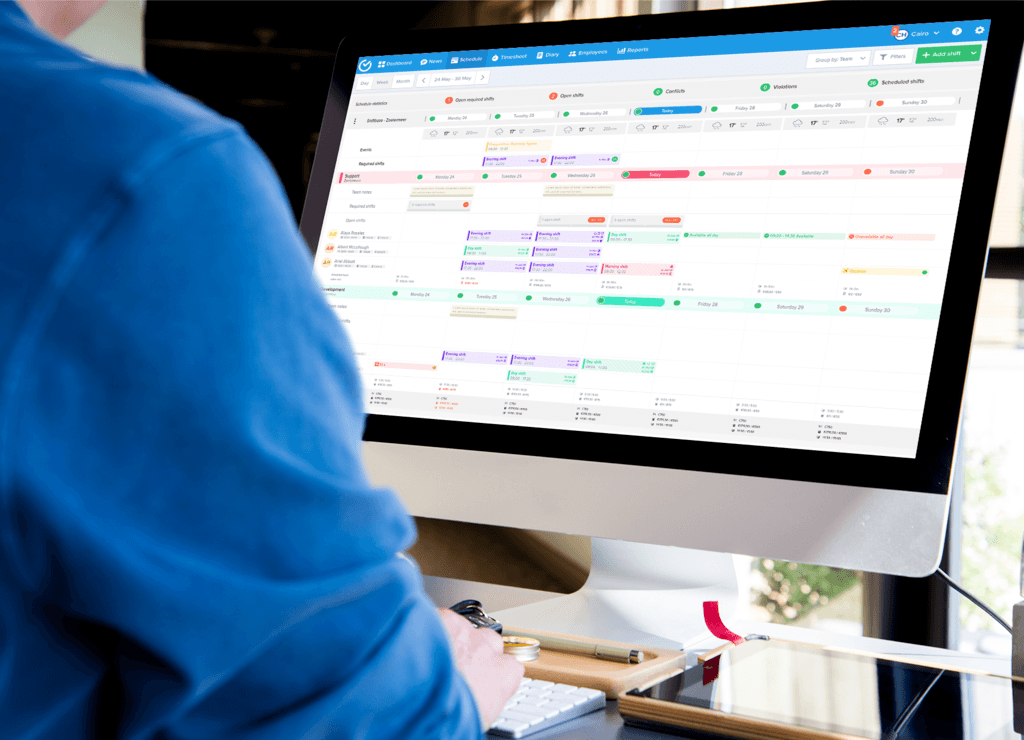Whether you're a seasoned shift manager looking to fine-tune your strategies or a newcomer eager to grasp the reins of productive scheduling, this comprehensive exploration will equip you with insights to optimize your workforce, enhance communication, and embrace the dynamic nature of shift work.
What is shift management?
Shift management encompasses the intricate art of creating and overseeing employee shift schedules to ensure smooth operations, uninterrupted services, and harmonious collaboration among teams.
This involves a delicate balance of understanding the organization's needs, employee preferences, and the ebb and flow of demand throughout different times of day or night. To truly excel in shift management, it's crucial to master the interplay between these elements and the underlying dynamics that govern them.
Benefits of effective shift management
lets take a look at some of the benefits of effective shift management:
Optimized shift schedules:
Effective shift management yields optimized shift work schedules that align seamlessly with fluctuating demand patterns. By utilizing data-driven insights and employing a reliable shift management tool, businesses can allocate the right number of night shift workers during periods of heightened demand, ensuring efficient operations even during non-traditional hours.
Enhanced work-life balance for night shift workers:
Managing night shifts can often disrupt employees' natural circadian rhythms and work-life balance. Skillful shift management considers the well-being of overnight shift workers, distributing night shifts fairly and minimizing consecutive night shifts. This approach fosters better physical and mental health for these employees, translating into higher job satisfaction and retention rates.
Reduced operational inefficiencies:
With a well-designed shift schedule, operational inefficiencies such as gaps in coverage or excessive overlapping shifts can be minimized. Effective shift management ensures that resources are optimally allocated, eliminating instances of empty shifts or excessive labor costs. This leads to smoother workflow continuity and enhanced cost-effectiveness.
The role of shift management in workforce optimization

- Strategic alignment: Effective shift management is the linchpin of workforce optimization. By strategically aligning employee shifts with peak demand periods, organizations can maximize efficiency and productivity. This alignment prevents the underutilization or overburdening of staff, leading to higher employee morale and customer satisfaction.
- Resource allocation: Shift management is the compass guiding resource allocation. Assigning shifts intelligently ensures that the right skills are available at the right times, preventing bottlenecks and lags in production. By addressing skill gaps, shift managers create a seamless workflow that can respond to dynamic demands.
- Employee wellbeing: Beyond the mechanics of shift schedules, effective shift management acknowledges the human element. Considerate shift scheduling takes into account employee preferences and personal obligations, fostering a healthy work-life balance that enhances job satisfaction, retention rates, and overall team morale.

Your work schedule in one central place!
Key components of effective shift management
1. Accurate workforce forecasting
Understanding demand is the cornerstone of successful shift management. By analyzing historical data, businesses can anticipate the peaks and troughs in demand, aligning employee shifts with these patterns to avoid understaffing or overstaffing.
Useful Read: Efficient Workforce Capacity Planning: A Comprehensive Guide
Types of Historical Data:
-
Transaction data: Insights from past transaction volumes provide a clear picture of when customer demands are highest.
-
Seasonal trends: Recognizing recurring seasonal patterns helps adjust shifts to accommodate fluctuating demand.
-
Historical performance: Evaluating previous shift performance allows for data-driven adjustments and improvements.
2. Creating efficient schedules
Effective shift management involves synthesizing employee preferences for specific shifts with the operational requirements of the business. This balance fosters engagement and commitment among employees while ensuring coverage during critical periods.
Crafted shift schedules should seamlessly transition from one shift to another, minimizing gaps and overlaps. This prevents inefficiencies and guarantees a continuous workflow, enhancing productivity and customer satisfaction.
3. Communication and transparency
Open and transparent communication of shift schedules is paramount. Employees should be well-informed about their shifts well in advance, reducing confusion and enabling them to plan their personal lives accordingly.
Leveraging shift management software facilitates convenient access to schedules, enabling employees to view, request changes, or swap shifts effortlessly. This not only streamlines processes but empowers employees to take ownership of their schedules.
4. Flexibility and adaptability
Shift management's true test lies in its ability to manage unforeseen disruptions. Robust contingency plans and protocols are essential to mitigate the impact of unexpected events on operations.
A well-prepared shift management strategy includes predefined contingency plans that can be swiftly activated in emergencies. These plans outline steps to redistribute workloads and ensure minimal disruption to the workflow.
Best practices for implementing shift management

Efficient shift management is not merely a mechanical process but an art that balances the operational needs of an organization with the preferences and well-being of its employees. To truly excel in this realm, implementing the following best practices is crucial.
1. Utilizing technology solutions
-
Employee scheduling software: The heart of modern shift management lies in leveraging sophisticated employee scheduling software. These tools streamline the complex task of crafting intricate shift schedules, taking into account factors like employee availability, skills, and compliance requirements.
-
Time tracking and attendance tools: Complementing your shift management system with time tracking and attendance tools enhances accountability. These tools not only ensure that employees adhere to their designated shift hours but also provide valuable data for analyzing employee performance and attendance patterns.
2. Empowering employees
-
Involving employees in the scheduling process: Recognize that shift workers are key stakeholders in the process. Involving them in shift planning, to some extent, can provide insights into their preferences and constraints. While complete autonomy might not always be feasible, seeking their input fosters a sense of empowerment and belonging.
-
Allowing for shift swapping and self-service scheduling: Life's demands are often unpredictable. Allowing employees to swap shifts with colleagues or request changes through a self-service system adds a layer of flexibility and reduces the administrative burden on managers. This not only accommodates personal needs but also strengthens employee camaraderie.
3. Regular review and optimization
-
Analyzing schedule performance and effectiveness: Regularly reviewing the performance of your shift schedules is crucial. Are your employees performing optimally during their assigned shifts? Are there persistent gaps or overlaps that need addressing? Data-driven analysis provides insights into the effectiveness of your current approach.
-
Making adjustments based on feedback and data: Shift management is an evolving process. Gathering feedback from employees and analyzing performance data can guide adjustments to your shift schedules. Adapting to changing business needs, employee preferences, and emerging trends ensures that your schedules remain relevant and efficient.
Useful Read: Employee Management Software for small business - A Guide
Mastering the art of shift management involves a delicate dance of balancing the organizational needs with employee satisfaction.
Overcoming common shift management challenges
Navigating shift management comes with its fair share of challenges. Addressing these hurdles head-on is essential to maintaining a harmonious and productive work environment. Here's how you can overcome some of the most prevalent challenges:
1. Dealing with employee burnout
-
Managing overtime and workload distribution: One of the leading causes of burnout is excessive overtime. Shift managers should carefully monitor overtime hours and distribute the workload equitably among employees. Implementing a cap on overtime hours and ensuring fair distribution can prevent burnout while maintaining productivity.
-
Providing opportunities for rest and recovery: Regular rest and recovery are crucial for preventing burnout. Incorporate regular breaks into shift schedules and offer employees the chance to recuperate. By fostering a culture that values well-being, you can reduce burnout and enhance employee performance.
2. Ensuring fairness and equality
-
Avoiding favoritism in scheduling: Fairness in shift scheduling is paramount. Shift managers should remain impartial and transparent, avoiding any perception of favoritism. Utilize automated scheduling tools that consider employee availability and preferences objectively, minimizing the potential for bias.
-
Addressing concerns about equity and bias: Openly address concerns related to equity and bias in shift scheduling. Encourage employees to voice their concerns and suggestions, and be willing to adjust schedules if valid issues are raised. Regular communication and transparency demonstrate your commitment to fairness.
3. Compliance with labor laws
-
Understanding legal requirements for scheduling: Shift managers must have a comprehensive understanding of labor laws and regulations related to scheduling. Different jurisdictions may have varying rules about overtime, rest periods, and shift length. Staying informed and up-to-date ensures that your schedules align with legal requirements.
-
Adapting to changes in labor regulations: Labor laws can evolve, and it's crucial to adapt your shift management practices accordingly. Regularly review and adjust schedules to comply with any new regulations. Utilize shift management software that allows you to easily implement changes and stay compliant.
Enhancing shift management for optimal results

While the previous sections have explored the fundamental aspects of shift management, there are additional considerations and strategies that can further elevate your approach. To truly excel in managing shifts and optimizing your workforce, consider these valuable insights and practical tips:
1. Catering to early morning and night shift workers
-
Balancing between early morning shift and night Shift: Acknowledge the unique challenges that early morning (first shift) and night shift workers face. Distribute these shifts fairly among employees to prevent burnout and ensure a diverse distribution of less desirable shifts.
-
Employee well-being: Prioritize the well-being of night shift workers by providing appropriate breaks and well-lit workspaces. Establish clear communication channels for any concerns they might have and encourage feedback to continually improve their working conditions.
2. Shift management tips for seamless operations
-
Standardizing shift definitions: Ensure that shift definitions are consistent and well-understood by all employees. Ambiguities in shift start times, end times, and break durations can lead to confusion and disruptions.
-
Cross-training: Cross-training employees to handle multiple roles and shifts can provide flexibility in your scheduling. This reduces the dependency on specific employees for certain shifts, making it easier to manage changes and unexpected absences.
-
Consistent communication: Keep communication lines open and consistent. Regularly update employees on any changes to shift schedules, and encourage them to raise concerns or swap shifts through approved channels.
3. Emphasizing the importance of shift management
Useful Read: 6 Metrics to Measure Employee Engagement: The Employers Guide
-
Continuous improvement: Shift management should be an evolving process. Encourage a culture of continuous improvement by regularly evaluating the effectiveness of your strategies, seeking feedback, and making necessary adjustments.
-
Leadership support: Highlight the importance of effective shift management to upper management. When leadership understands the significance of well-organized shifts, they are more likely to provide the necessary resources and support.
4. Leveraging technology to improve shift management
-
Automated scheduling: Utilize shift management software to automate the scheduling process. These tools consider various factors such as employee availability, skill sets, and labor laws to create optimal schedules.
-
Real-time updates: Implement systems that allow for real-time updates and notifications. This enables employees to access the latest schedule changes and keeps them informed about any unforeseen developments.
As organizations continue to evolve and adapt to the demands of the modern workforce, effective shift management remains a cornerstone of success.

Employee scheduling and Time-tracking software!
Conclusion
Shift management serves as the cornerstone of successful modern business operations. Whether you're a seasoned manager or a newcomer, the insights provided empower you to excel in workforce management, communication, and adaptation.
By mastering the delicate balance of operational efficiency and employee satisfaction, you lay the foundation for a harmonious and thriving work environment that adapts to the dynamic demands of today's business landscape.
Elevate Your Shift Management with Shiftbase
Navigating the complexities of shift management in today's globalized world requires robust tools that simplify scheduling, track hours, and manage absences with precision. Shiftbase emerges as a formidable ally in this endeavor. By integrating essential features such as employee scheduling, time tracking, and absence management, this software transforms shift management from a daunting challenge into a streamlined process. Embrace the future of efficient shift management. Try Shiftbase for free for 14 days and experience the difference firsthand!




